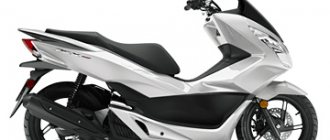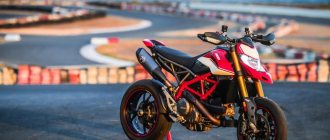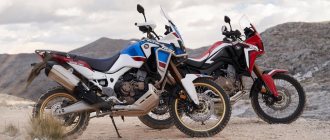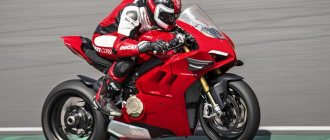History of Moto Guzzi
But let's take things in order. The history of Moto Guzzi, like almost any Italian motorcycle brand, is complex and controversial. Ups, downs, bankruptcy, change of owners, traditions, innovations and that's all. Since 2004, Moto Guzzi has been under the control of the Piaggio concern, which owns many other Italian motorcycle brands - Aprilia, Vespa and five more.
Under Piaggio's leadership, the brand has performed smoothly, especially in light of the introduction of Euro4 econorms in 2016. Unfortunately, many Moto Guzzi models did not pass these standards, so the Griso, Norge, Stelvio and others sank into oblivion. And the remaining MGX-21 bagger and V9 bobber are specific vehicles in which charisma prevails over the ability to drive fast or on less than smooth asphalt.
Moto Guzzi V85 TT 2020
Don't get me wrong: I like charismatic bikes, I even have an Indian Chieftain on my phone screensaver. And then, one fine day, almost unexpectedly, I found myself riding a magnificent Moto Guzzi V85 along a picturesque winding mountain path, with a mechanic accompanying me behind me.
It was an impressive experience! I completely understand why the guys from Moto Guzzi are talking so passionately about the new model. But that’s if you don’t think about the price.
Moto Guzzi V85 TT 2022
The initial data is as follows: a new engine sits in a new frame and all this is surrounded by new electronic bells and whistles. Everything is at a very modern level, as if those models that did not pass the environmental test never existed. Once upon a time, both Triumph and Harley Davidson made motorcycles that were outdated even before they were removed from the stocks at the factory, but now this is no longer the case. So why shouldn't Guzzi make truly new motorcycles?
A little more detail:
The V85 TT, like any Moto Guzzi, is designed to be a worthy companion to its engine, explains Diego Arioli, Head of Marketing at Moto Guzzi.
Engine
It’s somehow difficult for me to imagine a motorcycle that is not worthy of the engine installed in it, but I think we all understand what Diego means. The 853 cc air-cooled engine installed in the Moto Guzzi V85 TT 2022 is the center of the motorcycle, its heart and its essence. This is exactly what you will talk about with understanding people and smile condescendingly at neophytes with the words “Well, this is Guzzi, you need to understand.” This is exactly why people buy a Moto Guzzi... Something that makes you forget about everything else.
Moto Guzzi V85 TT 2020
Moto Guzzi claims this is a new engine, but doesn't explain how it specifically differs from the 853cc air-cooled engine found in the V9 Bobber and V9 Roamer. They probably think the numbers will speak for themselves: 80 hp. and 80 Nm versus the previous 55 hp. and 62 Nm from the V9 series engine.
Electronic equipment
The engine, dry clutch and tubes in the tires are at least old school, but that's not until you look at the electronics. Moto Guzzi installed in the V85 TT all the electronic gadgets that they generally have: customizable traction control and ABS, riding modes, cruise control, a tablet device with a bunch of different numbers and settings, the ability to communicate with a smartphone and configure some parameters from a special application, LED light and one hell of an eagle-shaped daytime running light that crosses both headlights at once, which Moto Guzzi mentioned no less than five times during the presentation. They are very proud of it (and the fact is that the Moto Guzzi logo contains an image of an eagle in memory of one pilot who died in the First World War. A group of his friends founded this brand)
Moto Guzzi calls the V85 TT a “classic enduro,” seemingly finding (or dreaming up) a niche in the dual-sport motorcycle class. According to brand representatives, the market now includes crossovers, light enduros, scramblers and tourenduros. They did not give specific examples, but expressed themselves in the spirit of “this class cannot do this, and such and such a class cannot do this,” and so on. And the V85 TT, they say, is suitable for everything: urban everyday driving, touring and off-road riding. The first two points are absolutely certain, but I would argue about the third.
MOTO GUZZI V85 TT
The Italian company Moto Guzzi has already tried to build a touring enduro four times. The first were the V35-65TT in 1985, which even took part in the Paris-Dakar race, the second attempt was the NTX 350-650 (1986) with a fixed headlight and a small fairing, then there were the Quota 1000-1100 (1999) and Stelvio 1200 (2007 ). It seems like a little, but enough not to say that the V85TT was created from scratch. But those motorcycles were not so charismatic and great that they could simply make money by copying them.
The Moto Guzzi V85TT is not an exact copy of motorcycles from 35 years ago, but a modern interpretation of them based on fresh electronics and the classic Mondello V90 engine with a longitudinal crankshaft, a dry single-plate clutch, like on a car, and a cardan drive to the rear wheel. Simple, reliable, trouble-free. Everything we old motorcyclists love.
I'm pleased with the very comfortable seating position: vertical back, footrests at the bottom, wide and conveniently located steering wheel - you can stand up at any time. And it’s comfortable to ride standing up: the steering wheel is a little low for this, but your legs hold the motorcycle firmly. There is enough suspension to ride 90-100 on a gravel roadside, even just sitting in the saddle, and there is enough ground clearance to ride up and down stairs. At the very top, when leaving, it would be good to give a little gas in order to jump out and not hit your belly. Yes, the engine is covered from below with an aluminum pan, but the beauty of this wrinkle will still be unpleasant.
There is aerodynamic noise while driving. This is not a whistle, but a hum, like in a fan room. I went to adjust the glass. Yes, it is adjustable, but only the angle of inclination changes and only with a hexagon in place, and not with thumbwheels on the go. I lowered it to the lower position and, oddly enough, it became quieter. I also noticed a side effect: it perfectly blows raindrops down from the visor. That is, you need to once adjust the angle of attack of the glass to suit your height, tighten it tightly and not touch it again. If the standard glass is categorically not satisfactory, you will have to take radical measures - cut it or add a spoiler adjustable in height and angle of attack. Well, or wait until tuning appears from aftermarket glassblowers.
The V85TT has a fantastically soft clutch. I didn't think it was possible to make such a soft lever on a motorcycle with an 851 cc engine and a cable drive. At the same time, its information content is excellent: the moment of engagement is felt clearly, you can move off smoothly without adding gas. There are six gears in the box, they shift smoothly and accurately if you squeeze the lever, but are quite noisy if you just do this while releasing the gas. So don't be lazy, use the clutch when shifting.
When releasing the gas, a very slight deceleration is obtained. For some reason the motorcycle's engine brakes sluggishly, even though the specifications do not say anything about a reverse slip clutch. The behavior is similar to a scooter - you close the handle and just roll forward with a very smooth decrease in speed. There are no cables running from the handle to the intake. Only a wire transmitting rheostat readings about the angle of rotation. And the brains are already making decisions about the degree and speed of opening and closing the air dampers by the servo drive and the amount of gasoline injected by the injectors. Perhaps the smooth closing of the dampers is simply programmed into these brains, and this softens engine braking.
The gear engaged indicator is mathematical. It calculates the gear number based on the current speed and engine speed. When the clutch is depressed, it shows nothing but neutral, because the signal for neutral is taken from the sensor in the gearbox.
At the rear there is a good, fat shock absorber. There is only one and is located not in the center, but on the right. But the pendulum is not a console, as it might seem, but an ordinary two-armed one, although the second arm is not so massive - the cardan shaft does not pass through it. The shock absorber and front fork have adjustments for spring preload and rebound hydraulics. The fork itself is an inverted type, but not very thick - only 41 mm in diameter. The suspension travel is the same – 170 mm. They are not off-road, but rather all-terrain, for hard surfaces - asphalt, crushed stone, rolled primer. Moreover, the asphalt may not be ideal - on a broken road with cracks and patches of pothole repair, the Guzzi drives briskly at 100–120, confidently absorbing these irregularities.
Curb weight with tank 90% full – 229 kg. But everything iron and heavy in the motorcycle is located below, so it does not frighten at the slightest deviation from the vertical. It does not try to fall and crush the driver in the process. It's easy to hold in place and when maneuvering at low speeds. And the seat is not too high - 830 mm, people of average height will not have problems putting both feet on the ground at stops. It’s convenient to roll the Guzzi around the garage with one hand on the steering wheel and the other on the trunk pipes - a clear, grippy design. The side poker has a large loop for tilting with your foot; you can find it by touch. But there is no central stand. On the one hand, with a cardan drive it is not really needed, because the chain does not need to be lubricated and adjusted, but somehow it is more convenient to check the oil level, carry luggage, and store it in the garage in winter.
Wheel sizes are 110/80–19 and 150/70–17. This was the standard five to ten years ago; you can find pure asphalt tires, 50/50 tires, and even “evil” tires for off-road conquering. Metzeler Tourance Next or Michelin Anakee Adventure are standard - both options suit this motorcycle well. They do not buzz, hold up well on dry and wet asphalt, last a long time, and also allow you to confidently move on gravel and hard ground. But if you are drawn to travel around the world, then I would advise you to buy Mitas E-07+ - it will feel better in those countries where asphalt has not yet been invented.
Two bulging headlights with DRLs are the most controversial design element of the V85TT. Very similar to a big-eyed duck with a humpback beak. I like it, but some call it ugliness. But the headlights are technically made correctly. The eagle lights up during the day, in the evening low-beam diodes are added, filling the road with two horizontal stripes - one closer, the second a little further from the front wheel. You can also turn on the distant one, which shines a locomotive searchlight forward into the horizon.
Blinking in the distant daylight is clearly visible to drivers - they willingly part, freeing up the aisle. In general, despite the wide steering wheel, the wind protection mugs that add dimensions and even wider mirrors, driving the V85TT in traffic jams is not difficult. Either the steering wheel is the right height, or it is narrower than it seems, but driving in traffic jams is not annoying, and even brings pleasure. The motorcycle dives from row to row easily and confidently, helped by good handling and a large steering angle.
The classic V2 from Guzzi with a longitudinal crankshaft is stylish and fashionable, but not at all youthful. There is one camshaft above the knee, from which there are valve pusher rods that rest against the rocker arms and, believe it or not, push the valves. In the intake tract there is one damper and one injector for two cylinders. This scheme, practiced at Guzzi for more than half a century, has been brought to perfection and is highly reliable and reliable. But that didn't stop her from becoming obsolete. The engine is sluggish: at the stand the motorcycle showed 79.2 hp. on the shaft at 80 declared by the manufacturer. The difference, of course, is minimal and is explained by the fact that the motorcycle was, as they say, out of the box, not run-in. But this is on the shaft. Less will go to the rear wheel, because there will be losses in the dry single-disc clutch, gearbox, and rear wheel gearbox. For 853 cubic meters of volume and 229 kg of curb weight, 80 forces is not enough.
But the thrill of this engine is not in the power as such, but in its distribution: 90% of the engine’s torque is available from 3750 to 7000 rpm. The torque graph is completely flat in this range, and the power graph peaks at 7000, then goes flat until about 7600 and then stops. This allows you to drive cheerfully and even brazenly, turning the engine not to the red zone of 8000, but to 6000–7000, then shifting up and getting into the meatiest zone, which provides good acceleration.
The two-valve design of the heads and the piston stroke, which is not far behind the cylinder diameter, ensures good traction at the “bottoms”. The Guzzi responds to a turn of the throttle with a soft and confident jump forward, like Bagheera in the Soviet cartoon about Mowgli. But, like any cat, this is only a jump, not a long run. The engine quickly turns sour, and then completely hits the rev limiter. This response at the “bottoms” allows you to drive off-road without extreme pressure, but forces you to often use the gearbox foot when trying to drive quickly on asphalt.
A dashboard with a painted tachometer and eight blinker lamps flashing in pairs above the color display helps you navigate what’s happening with the engine. The response speed is adjustable. First, the orange ones light up in pairs, then the first red pair, and at the very end a second red pair is added, and they all begin to blink frantically. It's impossible not to notice.
The same lights display the activation of traction control and the Continental traction control system. The lights flicker when jumping over “dead cops” and when trying to unscrew the throttle too quickly when accelerating on dirty asphalt. In short, you won’t be able to effectively skid your tail; the electronics won’t let you until you forcefully turn it off through the menu.
There are 3 engine operating modes – Strada (road), Rain (rain) and Enduro (off-road). The first is universal, in the second the throttle response is smoother, traction and ABS work earlier. In the third, the rear wheel ABS is turned off and can be effectively blocked. The trip computer shows travel time, average speed, maximum speed and how far you can travel on the remaining petrol. The tank is large, 23 liters, after full refueling, the mighty figure of 550 km was displayed on the dashboard. It also reports instantaneous and average consumption, but not in l/100 km, but in km/l. A little unusual, but you can adapt.
To be honest, I have only one complaint about this motorcycle - not enough power. If you put a chain drive on two pairs of overhead camshafts, 4 valves in each cylinder, increase the volume to a liter, and the power to 105-110 honest forces, it would be a bomb. And so it turned out to be a calm motorcycle for people who are confident and successful in this life, who don’t fuss, but just ride. Comfort, appearance and the aura of the brand are more important to them than the numbers in the technical specifications table. Moto Guzzi is the kind of Italian Harley-Davidson that has no need to be at the forefront of progress. Both of these companies monetize completely different life values and touch different heartstrings.
The V85TT turned out to be not a retro tourenduro, as the Moto Guzzi company itself positions it, but an ordinary tourist for medium-quality paved roads. It has a slightly archaic engine, average power ratings and design notes from the 80s of the last century. But this is a modern motorcycle, with up-to-date electronics and good handling. It is also simple and repairable, which allows us to seriously talk about the reliability of this cute pop-eyed duck.











